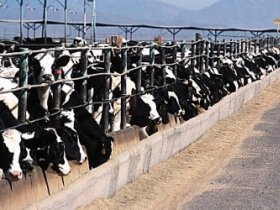Put more nitrogen into milk, not manure

The more efficient dairy farmers are in managing nitrogen, the more milk their cows will produce and the less nitrogen will be wasted in manure and urine, according a study by US Agricultural Research Service (ARS) scientists and cooperators.
ARS soil scientist J. Mark Powell at the US Dairy Forage Research Center in Madison, Wisconsin, worked with ARS agricultural engineer Clarence Rotz at the ARS Pasture Systems and Watershed Management Research Unit in University Park, Philadelphia, and Australian colleagues to calculate nitrogen use efficiency ratings to guide dairy farmers.
These new efficiency ratings could help dairy farmers make better use of their nitrogen in the face of escalating costs and increasing nutrient regulation.
Farmers feed nitrogen in the form of crude protein to their cows, and apply manure and nitrogen fertilizer to grow crops and pasture for cows to eat and convert to milk.
Nitrogen in milk
The scientists found that only about 20 to 35% of the nitrogen fed to dairy cows is converted into milk. They also discovered that 16 to 77% of the nitrogen in manure or fertilizer is necessary for grass and other pasture plants.
And their study showed that between 8 and 64% of all the nitrogen applied to typical commercial dairy farms is converted into farm products.
They determined the whole farm nitrogen use efficiency by applying the ARS-developed Integrated Farming System Model on two typical dairy farm types in Wisconsin.
They used the model to quantify the effects of numbers of cows per acre and manure nitrogen credits (reducing fertilizer nitrogen applications when manure is applied) on nitrogen use, farm profitability, and pathways of nitrogen loss.
Room for improvement
The wide ranges in nitrogen use efficiency point to the fact that there is significant room for improvement by using various practices that improve nitrogen use, profits, and the environment.
Nitrogen use efficiency formulas can be used as tools to promote practices that maximize nitrogen use so that nitrogen does not leave farms to pollute waterways and ground water and negatively impact air quality.
From these tools, which are effectively a nitrogen efficiency audit, may come recommendations to dairy farmers, consultants, and policy makers.











